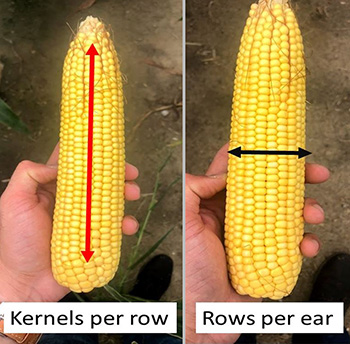Estimating corn yield potential
Estimating corn yield potential can help you make important decisions prior to harvesting.

With the harvest season quickly approaching (Yes, we are already ending the month of September, can you believe that?), Michigan farmers are getting excited to know their corn yields. With a wet spring and dry summer, the less than optimum growing season we faced could mean that corn yields will vary greatly from yields in previous years.
Estimating corn yields is something pretty simple—for the most part—and the numbers get more accurate as corn gets closer to maturity and as the sampled areas represent the variation of the field. Samples should be conducted for every 10-15 acres. If you have 30-inch corn, select a row and measure 17 feet 4 inches with a tape (17 feet 4 inches is the length of the row to equal 1/1000th of an acre). Narrower rows will use different lengths.
Count the numbers of ears in that row, then pick two to five corn ears to count the number of kernels per ear by multiplying the number of rows by the number of kernels within each row. Next, multiply the number of kernels per ear by the number of ears by 1,000, and you will get the numbers of kernels per acre.
Do not count aborted kernels or those on the tip of the ear, since they will not add to the overall yield. To get a more precise estimation, avoid odd, non-representative ears.
Overall, we accept an average of 75,000 to 80,000 kernels per bushel for excellent grain filling conditions; 85,000 to 90,000 kernels per bushel for average; and 95,000 to 105,000 kernels per bushel for poor conditions. When choosing the right filling conditions, take into consideration the management practices, weather conditions, nutrient availability and hybrid used. Based on how your season went, select which one to use in your calculation.
Now, with this information you will be able to estimate the number of bushels per acre. Divide the number of kernels per acre by the average of kernels per bushel based on your field condition, and this will give you the estimated yield for your field.

Example:
- Number of ears: We counted 24 ears in 17 feet 4 inches. (Don’t forget you are doing that for every 10-15 acres).
- Number of ears per acre: We multiplied the number of ears by 1,000 (24 ears x 1,000= 2,4000; 17 feet 4 inches is the length of the row to equal 1/1000th of an acre).
- Number of kernels per ear: We chose two to five ears for each row and counted the number of rows multiplied by the number of kernels per row and averaged the number in between the five ears. The average number of kernels per ear was 385 kernels per ear.
- Number of kernels per acre: We multiplied the number of kernels per ear (385) by the number of ears per acre (24,000). The result was 9,240,000 kernels per acre.
- Bushels per acre: The last step was to discover the number of kernels per bushel. We had to divide the number of kernels per acre (9,240,000) by the average number of kernels per bushel (given earlier). Since we considered our corn growing in poor conditions, we divided 9,240,000 by 105,000 (average kernels per bushel for poor growing conditions). The result was about 88 bushels per acre.
For more information on this topic or any other one related to agriculture, contact your local Michigan State University Extension county office.



 Print
Print Email
Email